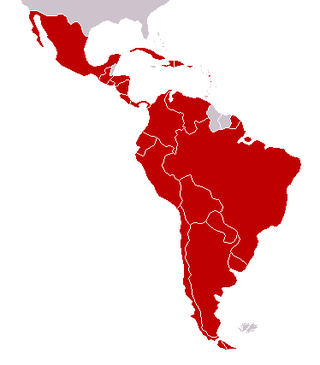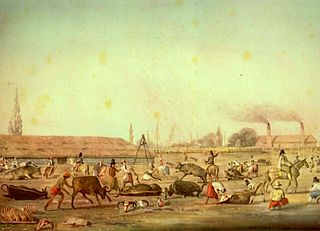
The economy of Paraguay is a market economy that is highly dependent on agriculture products. In recent years, Paraguay's economy has grown as a result of increased agricultural exports, especially soybeans. Paraguay has the economic advantages of a young population and vast hydroelectric power. Its disadvantages include the few available mineral resources, and political instability. The government welcomes foreign investment.

The economic history of Argentina is one of the most studied, owing to the "Argentine paradox". As a country, it had achieved advanced development in the early 20th century but experienced a reversal relative to other developed economies, which inspired an enormous wealth of literature and diverse analysis on the causes of this relative decline. Since independence from Spain in 1816, the country has defaulted on its debt nine times. Inflation has often risen to the double digits, even as high as 5,000%, resulting in several large currency devaluations.

Import substitution industrialization (ISI) is a trade and economic policy that advocates replacing foreign imports with domestic production. It is based on the premise that a country should attempt to reduce its foreign dependency through the local production of industrialized products. The term primarily refers to 20th-century development economics policies, but it has been advocated since the 18th century by economists such as Friedrich List and Alexander Hamilton.

Arturo Umberto Illia was an Argentine politician and physician, who was President of Argentina from 12 October 1963, to 28 June 1966. He was a member of the centrist Radical Civic Union.

Raúl Prebisch was an Argentine economist known for his contributions to structuralist economics such as the Prebisch–Singer hypothesis, which formed the basis of economic dependency theory. He became the executive director of the Economic Commission for Latin America in 1950. In 1950, he also released the very influential study The Economic Development of Latin America and its Principal Problems.
The Licence Raj or Permit Raj is a pejorative for the system of strict government control and regulation of the Indian economy that was in place from the 1950s to the early 1990s. Under this system, businesses in India were required to obtain licences from the government in order to operate, and these licences were often difficult to obtain.

Foreign trade of Argentina includes economic activities both within and outside Argentina especially with regards to merchandise exports and imports, as well as trade in services.

The economic history of Brazil covers various economic events and traces the changes in the Brazilian economy over the course of the history of Brazil. Portugal, which first colonized the area in the 16th century, enforced a colonial pact with Brazil, an imperial mercantile policy, which drove development for the subsequent three centuries. Independence was achieved in 1822. Slavery was fully abolished in 1888. Important structural transformations began in the 1930s, when important steps were taken to change Brazil into a modern, industrialized economy.
The economic history of the Republic of Turkey had four eras or periods. The first era had the development policy emphasizing private accumulation between 1923 and 1929. The second era had the development policy emphasized state accumulation in a period of global crises between 1929 and 1945. The third era was state-guided industrialization based on import-substituting protectionism between 1950 and 1980. The final, era was the opening of the economy to liberal trade in goods, services and financial market transactions since 1981.

The Infamous Decade was a period in Argentine history that began with the 1930 coup d'état against President Hipólito Yrigoyen. This decade was marked on one hand by significant rural exodus, with many small rural landowners ruined by the Great Depression, which in turn pushed the country towards import substitution industrialization, and on the other hand, by electoral fraud to perpetuate conservative governments in power. The poor results of economic policies and popular discontent led to another coup in 1943, the Revolution of 1943, by the Grupo de Oficiales Unidos (GOU), a nationalist faction of the Armed Forces, which triggered the rise to power of Juan Perón.
Between 1950 and 1960, the imperial government of Ethiopia enacted legislation and implemented a new policy to encourage foreign investment in the Ethiopian economy. This new policy provided investor benefits in the form of tax exemptions, remittances of foreign exchange, import and export duty relief, tax exemptions on dividends, and the provision of financing through the Ethiopian Investment Corporation and the Development Bank of Ethiopia. In addition, the government guaranteed protection to industrial enterprises by instituting high tariffs and by banning the importation of commodities that might adversely affect production of domestic goods. Protected items included sugar, textiles, furniture, and metal. The government also participated through direct investment in enterprises that had high capital costs, such as oil refineries and the paper and pulp, glass and bottle, tire, and cement industries. In 1963, with the Second Five-Year Plan under way, the government enacted Proclamation No. 51. The proclamation's objective was to consolidate other investment policies enacted up to that period, to extend benefits to Ethiopian investors, and to create an Investment Committee that would oversee investment programs. In 1966 the Ethiopian government enacted Proclamation No. 242, which elevated the Investment Committee's status as an advisory council to that of an authorized body empowered to make independent investment decisions. Thus, by the early 1970s, Ethiopia's industrialization policy included a range of fiscal incentives, direct government investment, and equity participation in private enterprises.

The railway natinalisation in Argentina occurred on March 1, 1948, during President Juan Perón's first term of office, when the seven British- and three French-owned railway companies then operating in Argentina, were purchased by the state. These companies, together with those that were already state-owned, where grouped, according to their track gauge and locality, into a total of six state-owned companies which later became divisions of the state-owned holding company Ferrocarriles Argentinos.

The Mexican miracle is a term used to refer to the country's inward-looking development strategy that produced sustained economic growth. It is considered to be a golden age in Mexico's economy in which the Mexican economy grew 6.8% each year. It was a stabilizing economic plan which caused an average growth of 6.8% and industrial production to increase by 8% with inflation staying at only 2.5%. Beginning roughly in the 1940s, the Mexican government would begin to roll out the economic plan that they would call "the Mexican miracle," which would spark an economic boom beginning in 1954 spanning some 15 years and would last until 1970. In Mexico, the Spanish economic term used is "Desarrollo estabilizador" or "Stabilizing Development."
The history of Argentina can be divided into four main parts: the pre-Columbian time or early history, the colonial period (1536–1809), the period of nation-building (1810–1880), and the history of modern Argentina.

The Argentine Industrial Union is the leading industrial employer federation and advocacy group in Argentina. The UIA is a member of the International Organisation of Employers.
The Five Year Plan was an Argentine state-planning strategy, during the first government of President Juan Domingo Perón.

Latin America as a region has multiple nation-states, with varying levels of economic complexity. The Latin American economy is an export-based economy consisting of individual countries in the geographical regions of North America, Central America, South America, and the Caribbean. The socioeconomic patterns of what is now called Latin America were set in the colonial era when the region was controlled by the Spanish and Portuguese empires. Up until independence in the early nineteenth century, colonial Latin American regional economies thrived and worked things out. Many parts of the region had favorable factor endowments of deposits of precious metals, mainly silver, or tropical climatic conditions and locations near coasts that allowed for the development of cane sugar plantations. In the nineteenth century following independence, many economies of Latin America declined. In the late nineteenth century, much of Latin America was integrated into the world economy as an exporter of commodities. Foreign capital investment, construction of infrastructure, such as railroads, growth in the labor sector with immigration from abroad, strengthening of institutions, and expansion of education aided industrial growth and economic expansion. A number of regions have thriving economies, but "poverty and inequality have been deeply rooted in Latin American societies since the early colonial era."
The Mitre Law, or Ley 5315 is a law passed in Argentina in 1907. The law overall did not enact any new principals, but its purpose was to justify and simplify the concession laws and overall regulations in Argentina with regard to the railroad industry. It was more of a gesture to foreign investors that had initially invested in building the Argentinian railroad system in the 19th century. The rail industry was very profitable for foreign investors in the 20th century, and the Mitre Law ensured that similar regulations would be continued and thus Argentina hoped for increased investment into their developing economy. it had the effect of an increase in foreign investments in railroads notably from British companies. Since Argentina lacked the iron and coal resources that were essential to an expanding economy during the industrial revolution, the Argentinian government had to offer generous deals with foreign investors because of the lack of such resources. The law permitted all railway companies, and not just foreign owned ones, to import most of their raw materials tax-free.
The economic history of Latin America covers the development of the Latin American economy from 2500 BCE to the start of the 21st century.

Since its formal organization as a national entity in the second half of the 17th century, Argentina followed an agricultural and livestock export model of development with a large concentration of crops in the fertile Pampas, particularly in and around Buenos Aires Province, as well as in the littoral of the Paraná and Uruguay Rivers. Between 1880 and 1930, the country witnessed remarkable economic advancement largely propelled by the exportation of beef and grain. Largely limited to stock-raising activities and centered on the export of cattle hides and wool, Argentine agriculture languished during the colonial era and well into the 19th century. Argentina's historical trajectory has been significantly shaped by the evolution of its agricultural sector.











